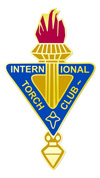
Meeting Minutes
Torch Club of the Fox Valley
12 March 2015
Atlas Coffee Mill & Café
Notes taken by: Jude Kuenn, secretary
Attendees: Nancy Bodway, Janet Wullner-Faiss Cloak, David Debbink, Marcia Debbink, Mary Flanagan, Paul Freiburg, Jean Jepson, Barbara Kelly, Bill Kelly, Jude Kuenn, Cam Maurice, Amy Oberg, Mary Paulson, Richard Schoenbohm, Katie Shaw, Webb Shaw, Jan Smith, Bob Swain, Margie Swain, Helen Thiel, Peter Thiel, Scott Valitchka, David Woods
Guests: none
BUSINESS MEETING
Meeting called to order at 6:37pm.
- Guests: none.
- Minutes from 02/12/15 meeting were accepted, motioned and approved.
- Treasurer’s report: 3/11/15 balance is $1,605.42. Since February meeting, expenses included IATC new member dues, dinner for prospective members and two new name tags. Report was accepted, motioned and approved.
- New Business:
A: Peter Thiel announced the slate of office nominees (for next two-year term): Richard Schoenbohm-President, Paul Freiberg-Vice president, Barbara Kelly-Treasure, and Jude Kuenn-Secretary. Motion was made to close nominations, move to slate and seconded. Slate accepted and approved. Thanks were extended to the Nominating Committee: Peter Thiel, Chairman, Janet Cloak, and Dwight Easty.
B. Call for delegates to attend annual IATC Convention 6/24-28/15, at the Holiday Inn Downtown, Lincoln, NE; the ‘Silicone Prairie’. This year’s theme is “Great Plains, Great Ideas”. (Registration must be made by 6/01/15. Fees per person payable at time of registration are: $350 before 4/01/15; $365 after 4/01/15.) IATC’s goal is to grow to 100 clubs, totaling 5,000 members by its centennial in 2024. - Announcements:
a. Amy Oberg brought a table full of gently used books to pass on to anyone interested in them.
b. Mary Paulson shared 3/18/15 Noonhour Philosophers’ speaker will be Jack Rhodes, former professor of Communication and Film Studies, past Board Chair of the Fox Valley Community Foundation and FVTC. - Business segment adjourned at 6:52pm for dinner.
Jan Smith presented “Italian Influence: Mosaic, Millefiori, and Murrine”
Early mosaic glass dates back to Egypt, 3rd c.b.c.e.
Small patterns created by ‘canes’, an example: pectoral breastplate, Egypt 3rd to 1st c.b.c.e.
Fused canes have Roman/Egyptian origin, were laid side-by-side, and heated to melt together
~50 a.d. started advent of glass blowing, example: satyr head
Stretched canes or ribbons of glass, laid side-by-side, 1st c.b.c.e. Method found within a 50-mile radius of Rome, proving ribbons were unique to the area.
Lampworking: led to the rise of the Venetian bead industry. Heat source was talo-burning lamp, from Roman times forward. ~ 1700s, discovery was made that shooting air through a flame intensified its heat. Examples included tableware, decorative knife handles, Louis XIV table measuring ~5 feet in diameter from mid-17th century.
Glass trade stayed in families 600 years or more, explains how techniques were carried on from generation to generation.
Glass altar pieces from southeast France, these artisans were close to the Italian border.
17th century bead making, rediscovered after a time gap. There was renewed interest in beads after Pompeii and Herculaneum archeological finds.
Domenico Bussolin, Venetian, married into a glass family, and made canes for sale, using a catalogue to show available color combinations.
Pietro Bigaglia was very successful making cane-handled goods, adding copper specks for brilliance.
In 1840, gaslights were introduced in Italy. Torch designed with gas, allowed consistent heat.
Pietro Bigaglia started new sensation in 1845: paperweights
French paperweight makers perfected millefiori 1845-1860
Clichy Glass Factory’s rose paperweights became popular, the rose symbolizing honesty and truth.
Millefiori style neglected until 1910 when Tiffany incorporated millefiori in his glass pieces.
1870 Italian fashion became monochromatic glasswork.
Carlo Scrapa, (1906-1978) Italian, brought glass to a new level of art in the 20th century.
Contemporary artist, Loren Stump’s forte is fine glass portraiture.
Other notes of interest:
Millefiori: type of mosaic glassware characterized by a flowerlike pattern
Murrine: Italian term for colored patterns or images made in glass can that are revealed when cut in cross-sections
Glass = silica, pot-ash as flux, sand and a neutralizer such as limestone
Colors of glass achieved by adding metals such as cobalt, gold, manganese and others
While the process is the same, today’s technology allows larger scale pieces. R&D can test component capability without glass loss, and heat source is moving from gas to electric, computerized for consistent results.